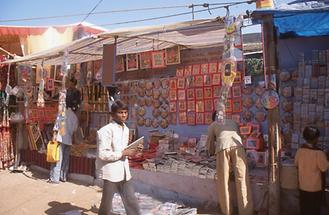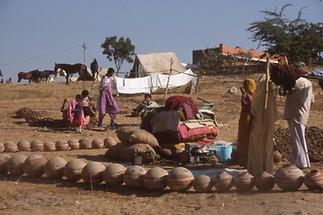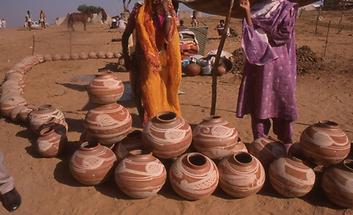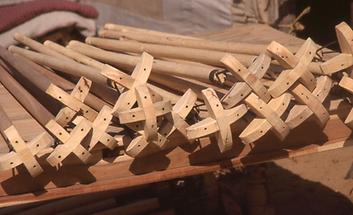Pushkar merchandise and food#
by G. JontesEating and drinking is necessary to stay strong and vital. Ordinary household cooking would not do for the very large crowds at the market. Hence peasant women are cooking on improvised places where they can light a fire. One can observe how everything is boiled, fried or cooked in hot ash. This is complemented by small kitchen stalls offering what we would tend to call fast food in other places: from noodle dishes, to skewers of fish or meat, the ominprensent versions of Indian bread, etc. Often different stalls cater to different customers for religious restraints. NOTE: All photos were taken by the author in the years 1986/87, 2001 und 2006 and are part of the archive "Pictureflood Jontes".
Essen und Trinken als die vitalen Grundlagen des Lebens sind im tagelangen Marktgetriebe nicht mit den Mitteln des eigenen Haushalts zu bewältigen. Bauersfrauen kochen deshalb für ihre Familie während des Marktes auf improvisierten Feuern. Man kann wie hier auch uralte Methoden des Garens wie das Backen in heißer Asche beobachten. Aber auch Garküchen größeren oder kleineren Leistungsvermögens versorgen mit den durch Religion und Sitte eingeengten Mitteln die Menschenmassen mit Nahrung. HINWEIS: Alle Bilder stammen aus dem Archiv "Bilderflut Jontes" und wurden vom Autor in den Jahren 1986/87, 2001 und 2006 aufgenommen.
 Merchandise and Food (1)
Merchandise and Food (1) Merchandise and Food (2)
Merchandise and Food (2) Merchandise and Food (3)
Merchandise and Food (3) Merchandise and Food (4)
Merchandise and Food (4) Merchandise and Food (5)
Merchandise and Food (5) Merchandise and Food (6)
Merchandise and Food (6)- Merchandise and Food (7)
- Merchandise and Food (8)
- Merchandise and Food (9)
- Merchandise and Food (10)
- Merchandise and Food (11)
- Merchandise and Food (12)
- Merchandise and Food (13)
- Merchandise and Food (14)
- Merchandise and Food (15)
- Merchandise and Food (16)
- Merchandise and Food (17)
- Merchandise and Food (18)
- Merchandise and Food (19)
- Merchandise and Food (20)
- Merchandise and Food (21)
- Merchandise and Food (22)
- Merchandise and Food (23)
- Merchandise and Food (24)
- Merchandise and Food (25)
- Merchandise and Food (26)
- Merchandise and Food (27)
- Merchandise and Food (28)
- Merchandise and Food (29)
- Merchandise and Food (30)
- Merchandise and Food (31)
- Merchandise and Food (32)
- Merchandise and Food (33)
- Merchandise and Food (34)
- Merchandise and Food (35)
- Merchandise and Food (36)
- Merchandise and Food (37)
- Merchandise and Food (38)
- Merchandise and Food (39)
- Merchandise and Food (40)
- Merchandise and Food (41)
- Merchandise and Food (42)
- Merchandise and Food (43)
- Merchandise and Food (44)
- Merchandise and Food (45)
- Merchandise and Food (46)
- Merchandise and Food (47)
- Merchandise and Food (48)
- Merchandise and Food (49)
- Merchandise and Food (50)